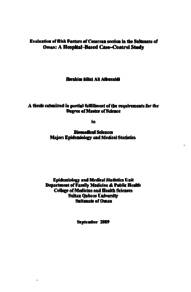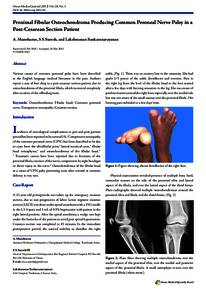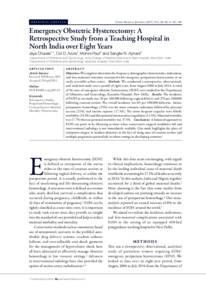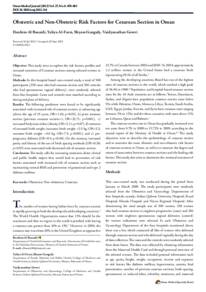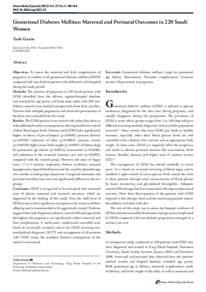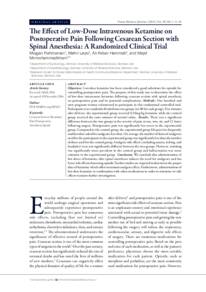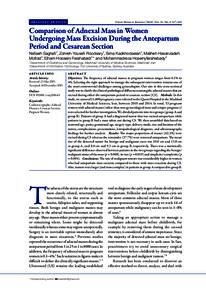وثيقة
Evaluation of risk factors of cesarean section in the Sultanate of Oman : a hospital-based case-control study
الناشر
Sultan Qaboos University
ميلادي
2009
اللغة
الأنجليزية
الموضوع
الملخص الإنجليزي
The number of women having babies born by cesarean section is growing rapidly in both the developed and developing countries. Likewise the cesarean section rate has increased gradually in Oman. We conducted a hospital based case-control study in order to describe the epidemiology of cesarean section and to ascertain the main Obstetric and non-obstetric risk factors of cesarean section in Oman. Moreover, we aim to measure the degree and extent of association between cesarean section and the leading risk factors in term of bivariate as well as multivariate and to study the neonatal outcomes of cesarean section. We used a hospital based case-control study of 250 cases and 250 controls. The cases represent those women who delivered through cesarean section deliveries and the controls represent those women who delivered through vaginal deliveries. The information was collected from maternity health green card and through face to face interviews. We used Chi-square test and odd ratio to assess the association between cesarean section and various characteristics under study with P-value less than or equal to 0.05 as a significant level of association. We have used also logistic regression to adjust for confounding factors and for multivariate analysis. The results of crude analysis of the study showed that among demographic risk factors age 40) (OR=3.01, 95% CI 1.10, 8.22), education (graduate and above) (OR=2.55, 95% CI 1.06, 6.13), high family income (> 1000 R.O) (OR=2.00, 95% CI 1.05, 3.81) were positively associated with the experience of cesarean section delivery. Among medical conditions complicating pregnancy, only gestational diabetes (OR=2.05, 95% CI 1.21, 3.50), having one or more previous cesarean section (OR=9.93, 95% CI 5.55, 15.71), abnormal fetal presentations were positively associated with the experience of cesarean delivery. Among contraceptive methods used by women only past used of IUCD method (OR=3.10, 95% CI 1.07, 8.99) was positively associated with the experience of cesarean section. Among physical activities of women, body mass index (obesity) (OR= 2.95, 95% CI 1.61, 5.39) dissatisfaction of body fitness (OR=1.65, 95% CI 1.14, 2.40) and a negative attitude toward exercise prevention from cesarean sections (women who did not think that exercise prevents from experiencing cesarean delivery) (OR=4.38, 95% CI 2.55, 7.55) were positively associated with cesarean section. Among health management variables, delivery time (7:00 am - 2:00 pm) (OR=2.39, 95% CI 1.65, 3.48), gestational age (<38 weeks) (OR=2.05, 95% CI 1.34, 3.13) and extremes of neonates birth weight(<2.50 kg and > 4.00 kg) (OR= 1.77, 95% CI 1.15, 2.7.4, OR=5.86, 95% CI 1.27, 27.09 respectively) were positively associated with cesarean section delivery.
After adjustment for education and parity as confounding factors of association between cesarean section and age, age (40) was still positively associated with the experience of cesarean section (OR=5.64, 95% CI 1.62, 19.60). After adjustment for age and parity as confounding factors of association between cesarean section and education, those women who had finished their college and above still had more risk to experience cesarean deliveries but the evidence of association became statistically not significant (OR= 1.79,95% CI 0.61, 5.27). After adjustment for age and education as confounding factors of association between cesarean section and parity, the increased parity was found to be associated with decreased risk of cesarean section delivery but the evidence of association was not statistically significant. After adjustment for age and education as confounding factors of association between cesarean section and family income, the evidence of association in general was significant and those women who had high family income still had increased risk of experience cesarean sections deliveries (OR=1.37,95% CI 0.66, 2.88). After we applied multivariate logistic regression ( backward step-wise ) for all risk factors under study, we conclude that age ( 40 years),pre-pregnancy diabetes, having one or more previous cesarean section delivery, abnormal fetal presentation, increased body mass index (obesity) and extremes of neonates birth weight (<2.50 kg and > 4.00 kg) were important predictor of cesarean section deliveries. Moreover we found that increased parity and past use of birth spacing methods other than intrauterine device were associated with decreased risk of cesarean section deliveries
الوصف
Thesis
المجموعة
URL المصدر
الملخص العربي
عدد النساء الآتي لديهن أطفال تم ولادتهم عن طريق العمليات القيصرية في ازدياد متسارع في كل من الدول المتقدمة والدول النامية. وكذالك الحال نسبة العمليات القيصرية إزدادت بشكل تدريجي في عمان. وقد قمنا بدراسة تعتمد على عينة مؤخذة من المستشفيات وذلك من أجل توفير تحليل وصفي عن العمليات القيصرية في عمان وتحديد أهم عوامل الخطر للعمليات القيصرية المتعلقة بشكل مباشر أو غير مباشر بالحمل. كما كان الهدف من الدراسة نقيم درجة ومقدار العلاقة بين العمليات القيصرية وعوامل الخطر على أساس التحليل الثنائي أو المتعدد ومن أجل دراسة الأطفال المولودون عن طريق العمليات القيصرية لقد استخدمنا دراسة التحكم المعتمده على المستشفى بمقدار 250 حاله (النساء الأتي ولدن عن طريق العمليات القيصرية) و 250 حالة تحكم ( النساء الأتي ولدن عن طريق الولادات المهبلية. تم جمع المعلومات عن طريق الأطلاع على المعلومات المدونة في البطاقة الخضراء الخاصة بالحوامل وعن طريق المقابلة الشخصية للأم. قمنا بإستخدام أختبار كاي- مربع لجودة الموافقة وحساب خطر الإصابة التقييم العلاقة بين العمليات القيصرية والخصائص المختلفة تحت الدراسة باخذ مستوى ثقة أقل من أو يساوي . 05 لتعيين أختبار الفرضية. كما قمنا باستخدام الانحسار اللوجستي المعدل للحد من تأثير بعض العوامل المؤثرة على العلاقة بين العمليات القيصرية والخصائص المختلفة تحت الدراسة بالأضافة إلى التحليل التدريجي اللوجستي التحوفي متعدد المتغيرات المعتمد على خطوة إلى الخلف. نتائج التحليل الأحادي الدراسة أظهرت أن من بين الخصائص الديموغرافية كان العمر (أكثر من 40 سنة) ( 8 . 22 , 1 . 10 OR = 3 . 01 , 95 % CI ) و التعليم (الخريجين فما فوق) OR = 2 . 55 , 95 % CI ) ( 6 . 13 , 1 . 06 والدخل الأسري المرتفع > 1000 ر.ع) ( 1 . 05 , 3 , 81 OR = 2 . 00 , 95 % CI ) لهن علاقة إيجابية مع العمليات القيصرية. ومن بين العوامل الطبية التي تتعلق بمشاكل الحمل كان سكري الحمل ( 3 . 50 , 1 . 21 OR = 2 . 05 , 95 % CI ) والتعرض لعملية قيصرية سابقة واحدة أو أكثر 9 . 93=OR) ( 15 . 71 , 5 . 55 CI 95 % والوضع الجنيني غير الطبيعي لهن علاقة إيجابية مع العمليات القيصرية. ومن بين وسائل المباعدة بين الولادات كان استخدام اللولب في الماضي له علاقة إيجابية بالعمليات القيصرية ( 8 . 99 , 1 . 07 OR = 3 . 10 , 95 % CI ). ومن بين عوامل نشاط المرأة الحركي كانت السمنة , . 95=OR) ( 5 . 39 , 1 . 61 CI 95 % وعدم الرضى عن رشاقة الجسم ( 2 . 40 , 1 . 14 OR = 1 . 65 , 95 % CI ) وعدم الاقتناع بأن للرياضة دور في تقليل العمليات القيصرية ( 7 . 55 , 2 . 55 OR = 4 . 38 , 95 % CI لهن علاقة إيجابية بالعمليات القيصرية. ومن بين العوامل الصحية الأخرى كان وقت الولادة ( 7 : 00 صباحا - 2 : 00 مساء) (3 . 48 ,1 . 65 OR = 2 . 39 , 95 % CI ) وعمر الحمل (38 أسبوع) OR = 2 . 05 , 95 % CI ) ( 3 . 13 , 1 . 34 و وزن الطفل عند الولادة (أقل من 2 . 50 كجم و أكثر من 4 . 00 كجم) %95 , 1 . 77=OR) ( 27 . 09 , 1 , 27 CI 1 . 15 , 2 . 74 , OR = 5 . 86 , 95 % CI لهن علاقة إيجابية مع العمليات القيصرية وبعد الحد من تأثير التعليم وعدد الولادات كعاملين مؤثرين على العلاقة بين العمليات القيصرية والعمر وجدنا أن العمر (أكثر من 40 سنة) ما يزال له علاقة إيجابية مع العمليات القيصرية %95 , 5 . 64=OR) ( 19 . 60 , 1 . 62 CI . وبعد الحد من تأثير العمر وعدد الولادات كعاملين مؤثرين في العلاقة بين العمليات القيصرية والتعليم وجدنا أن النساء اللائي انهين دراستهن الجامعية فما فوق مازلن أكثر عرضة لخوض العمليات القيصرية ولكن مستوى الثقة أصبح غير مؤثر ( 5 . 27 , 0 . 61 OR = 1 . 79 , 95 % CI وبعد الحد من تأثير التعليم والعمر كعاملين مؤثرين في العلاقة بين العمليات القيصرية وعدد الولادات وجدنا أن زيادة عدد الولادات مرتبط بنقص درجة الخطورة في التعرض للعمليات القيصرية ولكن مستوى الثقة في العلاقة كان غير مؤثر، وبعد الحد من تأثير كل من العمر والتعليم كعاملين مؤثرين للعلاقة بين العمليات القيصرية والدخل وجدنا أن مستوى الثقة في العلاقة بشكل عام كان مؤثر وان النساء اللاتي لديهن دخل أسري مرتفع ما زلن أكثر عرضة للعمليات القيصرية ( 2 . 88 ,0 . 66 OR = 1 . 37 , 95 % CI ). وبعد أستخدام التحليل التدريجي اللوجستي التحوفي متعدد المتغيرات لكل أسباب الخطر تحت الدراسة وجدنا أن العمر (أكثر من 40 سنة) سكري ماقبل الحمل ، التعرض لعملية قيصرية سابقة فأكثر، الوضع غير الطبيعي للجنين، زيادة حجم الجسم (السمنة) ونقص وزيادة وزن الطفل عن المعدل الطبيعي (أقل من 2 . 50 كجم وأكثر من 4 . 00 كجم ) كائن من أهم عوامل الخطر المسببة للعمليات القيصرية بالاضافة وجدنا أن زيادة عدد الولادات واستخدام وسائل المباعدة بين الولادات في السابق من غير اللولب كان لهن علاقة بانخفاض الخطر التعرض للعمليات القيصرية
قالب العنصر
الرسائل والأطروحات الجامعية

